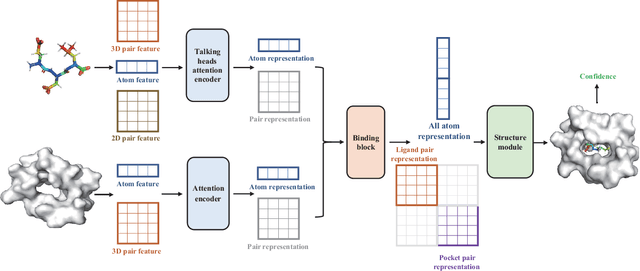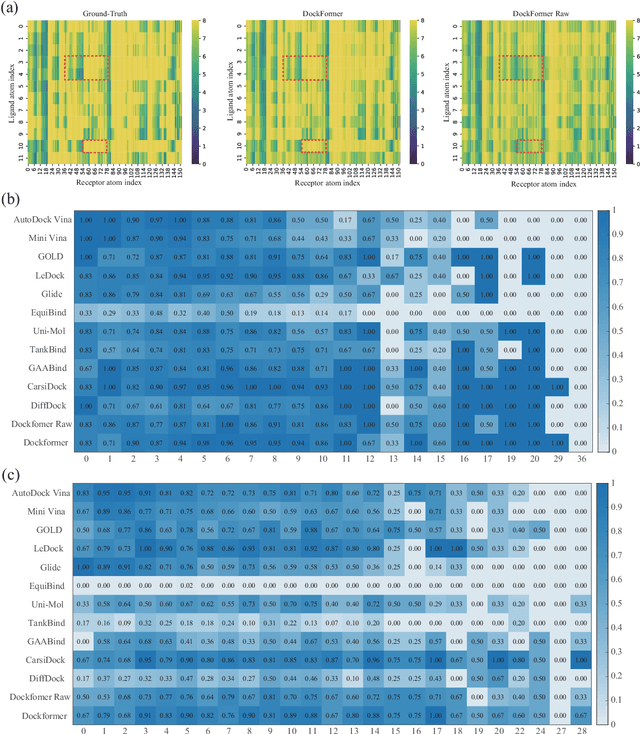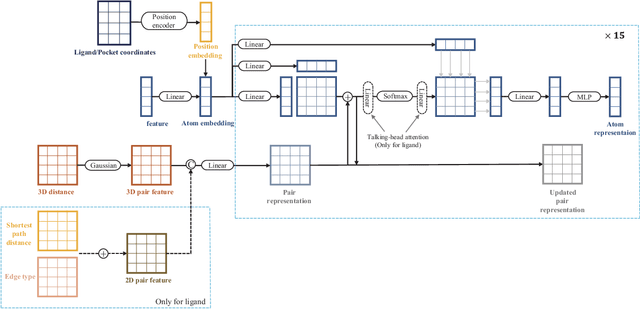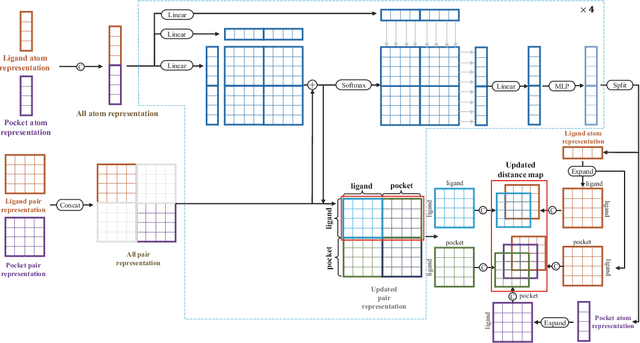Junkai Ji
MODA: A Unified 3D Diffusion Framework for Multi-Task Target-Aware Molecular Generation
Jul 09, 2025Abstract:Three-dimensional molecular generators based on diffusion models can now reach near-crystallographic accuracy, yet they remain fragmented across tasks. SMILES-only inputs, two-stage pretrain-finetune pipelines, and one-task-one-model practices hinder stereochemical fidelity, task alignment, and zero-shot transfer. We introduce MODA, a diffusion framework that unifies fragment growing, linker design, scaffold hopping, and side-chain decoration with a Bayesian mask scheduler. During training, a contiguous spatial fragment is masked and then denoised in one pass, enabling the model to learn shared geometric and chemical priors across tasks. Multi-task training yields a universal backbone that surpasses six diffusion baselines and three training paradigms on substructure, chemical property, interaction, and geometry. Model-C reduces ligand-protein clashes and substructure divergences while maintaining Lipinski compliance, whereas Model-B preserves similarity but trails in novelty and binding affinity. Zero-shot de novo design and lead-optimisation tests confirm stable negative Vina scores and high improvement rates without force-field refinement. These results demonstrate that a single-stage multi-task diffusion routine can replace two-stage workflows for structure-based molecular design.
Reimagining Target-Aware Molecular Generation through Retrieval-Enhanced Aligned Diffusion
Jun 17, 2025Abstract:Breakthroughs in high-accuracy protein structure prediction, such as AlphaFold, have established receptor-based molecule design as a critical driver for rapid early-phase drug discovery. However, most approaches still struggle to balance pocket-specific geometric fit with strict valence and synthetic constraints. To resolve this trade-off, a Retrieval-Enhanced Aligned Diffusion termed READ is introduced, which is the first to merge molecular Retrieval-Augmented Generation with an SE(3)-equivariant diffusion model. Specifically, a contrastively pre-trained encoder aligns atom-level representations during training, then retrieves graph embeddings of pocket-matched scaffolds to guide each reverse-diffusion step at inference. This single mechanism can inject real-world chemical priors exactly where needed, producing valid, diverse, and shape-complementary ligands. Experimental results demonstrate that READ can achieve very competitive performance in CBGBench, surpassing state-of-the-art generative models and even native ligands. That suggests retrieval and diffusion can be co-optimized for faster, more reliable structure-based drug design.
Dockformer: A transformer-based molecular docking paradigm for large-scale virtual screening
Nov 15, 2024



Abstract:Molecular docking enables virtual screening of compound libraries to identify potential ligands that target proteins of interest, a crucial step in drug development; however, as the size of the compound library increases, the computational complexity of traditional docking models increases. Deep learning algorithms can provide data-driven research and development models to increase the speed of the docking process. Unfortunately, few models can achieve superior screening performance compared to that of traditional models. Therefore, a novel deep learning-based docking approach named Dockformer is introduced in this study. Dockformer leverages multimodal information to capture the geometric topology and structural knowledge of molecules and can directly generate binding conformations with the corresponding confidence measures in an end-to-end manner. The experimental results show that Dockformer achieves success rates of 90.53\% and 82.71\% on the PDBbind core set and PoseBusters benchmarks, respectively, and more than a 100-fold increase in the inference process speed, outperforming almost all state-of-the-art docking methods. In addition, the ability of Dockformer to identify the main protease inhibitors of coronaviruses is demonstrated in a real-world virtual screening scenario. Considering its high docking accuracy and screening efficiency, Dockformer can be regarded as a powerful and robust tool in the field of drug design.
TransMUSIC: A Transformer-Aided Subspace Method for DOA Estimation with Low-Resolution ADCs
Sep 15, 2023Abstract:Direction of arrival (DOA) estimation employing low-resolution analog-to-digital convertors (ADCs) has emerged as a challenging and intriguing problem, particularly with the rise in popularity of large-scale arrays. The substantial quantization distortion complicates the extraction of signal and noise subspaces from the quantized data. To address this issue, this paper introduces a novel approach that leverages the Transformer model to aid the subspace estimation. In this model, multiple snapshots are processed in parallel, enabling the capture of global correlations that span them. The learned subspace empowers us to construct the MUSIC spectrum and perform gridless DOA estimation using a neural network-based peak finder. Additionally, the acquired subspace encodes the vital information of model order, allowing us to determine the exact number of sources. These integrated components form a unified algorithmic framework referred to as TransMUSIC. Numerical results demonstrate the superiority of the TransMUSIC algorithm, even when dealing with one-bit quantized data. The results highlight the potential of Transformer-based techniques in DOA estimation.
 Add to Chrome
Add to Chrome Add to Firefox
Add to Firefox Add to Edge
Add to Edge